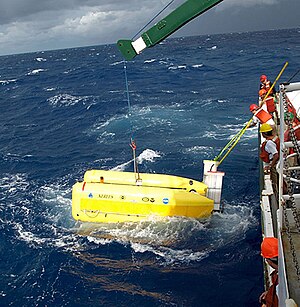 Nereus
| |
| History | |
|---|---|
| Name | Nereus |
| Owner | Woods Hole Oceanographic Institution (WHOI) |
| Operator | WHOI |
| Builder | WHOI |
| Acquired | 1995 |
| Commissioned | 2009 |
| In service | 2009~2014 |
| Homeport | Woods Hole, Massachusetts, United States |
| Fate | Imploded due to high pressure in Kermadec Trench 10 May 2014 |
| General characteristics | |
| Type | remotely operated underwater vehicle |
| Tonnage | 2,800 kilograms (6,200 lb) |
| Length | 3 metres (9.8 ft) |
| Installed power | electrical (rechargeable Lithium-ion batteries) |
| Speed | 3 knots |
| Test depth | 10,902 metres (35,768 ft) |
| Complement | unmanned |
| Sensors and processing systems | side-scan sonar & LED search lights |
Nereus was a hybrid uncrewed autonomous underwater vehicle (HROV, a type of remotely operated underwater vehicle) built by the Woods Hole Oceanographic Institution (WHOI). Constructed as a research vehicle to operate at depths of up to 11,000 metres (36,000 ft), it was designed to explore Challenger Deep, the deepest surveyed point in the global ocean. Nereus, named for Greek sea titan Nereus (who has a man's torso and a fish-tail) through a nationwide contest of high school and college students, began its deep sea voyage to Challenger Deep in May 2009 and reached the bottom on May 31, 2009.[1][2]
On this dive the Nereus reached a depth of 35,768 feet (10,902 m), making the Nereus the world's deepest-diving vehicle in operation at the time, and the first since 1998 to explore the Mariana Trench, the deepest known part of the ocean.[2][3]
On 10 May 2014, Nereus was lost while exploring the Kermadec Trench at a depth of 9,900 metres (32,500 ft). Communications were cut off at around 2 p.m. local time, and debris retrieved later revealed that it imploded due to high pressure.
- ^ Harlow, John (22 February 2009). "Old rivalries surface as US races to sea's deepest spot". London: The Sunday Times UK. Retrieved 2009-02-22.[dead link]
- ^ a b Cite error: The named reference
bbcwas invoked but never defined (see the help page). - ^ Cite error: The named reference
woodsholewas invoked but never defined (see the help page).